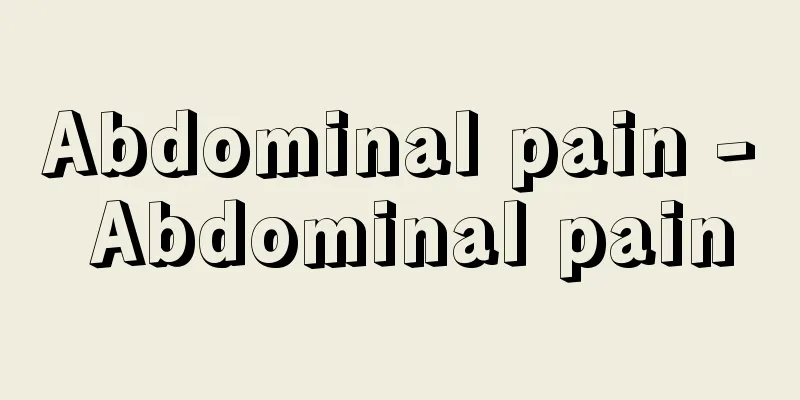Abdominal pain - Abdominal pain

|
Pain originating from the abdomen is a very common symptom that indicates the presence of abdominal lesions, but it can sometimes be caused by lesions in other areas besides the abdomen, such as the chest or spinal cord. Usually, abdominal pain is based on visceral pain and somatic pain, to which referred pain (radiating pain) is added. Visceral pain originates from the internal organs themselves, is a vague pain with no clear location. Causes include stretching, spasm, and expansion of the luminal organs (stomach, intestines, bile duct, ureter, bladder, etc.). Somatic pain is a sharp, localized pain that originates from the parietal peritoneum, mesentery, and the edges of the diaphragm, and is caused by mechanical or chemical irritation to the parietal peritoneum, etc. Also, referred pain includes the viscerocutaneous reflex and peritoneocutaneous reflex, which are radiating visceral pain and cause hyperesthesia and hyperalgesia in certain skin areas such as the shoulders to the back, indicating severe pain. Abdominal pain caused by diseases other than the abdominal area is also considered to be a type of referred pain. The most important step in treating abdominal pain is to first diagnose the underlying disease. To do this, it is necessary to examine the location and characteristics of the abdominal pain, as well as any accompanying symptoms. In terms of location, the relationship between spontaneous pain and tenderness is examined, and in terms of characteristics, it is examined by dividing it into colic and persistent pain. Colic is a condition in which visceral pain becomes stronger and referred pain is added to it, and is caused by spasms of the smooth muscles of the hollow organs, and often comes and goes intermittently. Sustained pain is mainly found in the parenchymal organs (liver, pancreas, etc.), and severe pain belongs to somatic pain, and can also be seen in cases of penetration or perforation of hollow organs. In addition to nausea and vomiting, accompanying symptoms include diarrhea, constipation, loss of appetite, vomiting blood, jaundice, and urinary problems. Below, we will discuss each area by location. (1) Epigastric pain This is what is known as upper abdominal pain, and can be seen in conditions such as peptic ulcers (gastric and duodenal ulcers), early stages of appendicitis, gallbladder disease, pancreatic disease, gastritis, and gastroptosis. If inflammation reaches the parietal peritoneum or adhesions or penetration are observed, referred pain or somatic pain is added and the location of the pain shifts. (2) Right hypochondriac pain This is what is known as right upper abdominal pain, and is primarily caused by liver, gallbladder, and bile duct diseases, including cholelithiasis, which is accompanied by radiating pain, and liver cancer, hepatitis, liver cirrhosis, and liver abscess, which are characterized by mild dull pain or a feeling of pressure. (3) Left hypochondriac pain: This is the left upper abdominal pain, which is generally caused by functional abnormalities, such as aerophagia, esophageal hiatal hernia, and gas retention in the splenic flexure of the colon, as well as lesions in the body and tail of the pancreas, the spleen, the transverse colon, and the splenic flexure of the colon. In addition, when accompanied by referred pain radiating to the shoulder or upper arm, it may be due to cardiac or thoracic disease. (4) Umbilical pain: This is pain around the navel, which is seen in functional and organic diseases of the small intestine, such as enteritis and ascariasis, as well as in the early stages of appendicitis. (5) Central lower abdominal pain: This is caused by increased internal pressure in part of the transverse colon and the descending colon, but can also be seen in diseases of the pelvic organs, genital diseases, and bladder and urinary tract diseases. (6) Right lower abdominal pain This is the so-called ileocecal pain, which is mainly caused by appendix, terminal ileum, and cecum diseases, but can also be caused by right renal disease, pelvic inflammation, or abdominal neuralgia. Acute appendicitis is a typical example, but other examples include ulcerative colitis and female genital diseases (salpingitis, endometritis, ovarian bleeding, etc.), and female genital diseases also cause pain in the left lower abdomen and central lower abdomen. (7) Left lower abdominal pain This can be seen in organic diseases of the rectum and sigmoid colon, as well as irritable bowel syndrome, left urinary tract diseases, and female genital diseases. (8) Whole abdominal pain This is pain in the entire abdomen, and can be caused by serious diseases, so be careful. In other words, a group of diseases in which the main complaint is sudden abdominal pain and in which it is necessary to quickly decide whether or not to perform laparotomy is called acute abdominal disease. In addition, when looking at the relationship between abdominal pain and meals, duodenal ulcers and gastric ulcers near the pylorus generally occur on an empty stomach, and are relieved by eating a meal or taking an alkaline agent. Pain immediately after eating is often due to gallbladder disease or a dysfunctional stomach or duodenum, and biliary colic often occurs 3 to 5 hours after eating. Abdominal pain in children differs from that in adults in the following ways: (1) it is often caused by diseases other than the abdominal area; (2) it is often seen as a precursor to acute abdominal pain or serious illness; (3) abdominal pain is often functional or psychogenic; and (4) in infants, diagnosis must be made based on objective symptoms. [Hosoda Shiro] Source: Shogakukan Encyclopedia Nipponica About Encyclopedia Nipponica Information | Legend |
|
腹部に発する痛みで、腹部の病変の存在を告げるきわめて一般的な症状であるが、ときには腹部以外の胸部や脊髄(せきずい)などの病変によっておこることもある。通常、腹痛は内臓痛と体性痛が基本となっており、これに関連痛(放散痛)が加わる。内臓痛とは内臓器官そのものからおこるもので、漠然とした痛みであり、部位感は明確でない。原因としては管腔(かんくう)性器官(胃、腸、胆道、尿管、膀胱(ぼうこう)など)の伸展、けいれん、拡張などがあげられる。体性痛とは壁側腹膜、腸間膜、横隔膜の辺縁部からおこる鋭い限局性の痛みで、原因としては壁側腹膜などに対する機械的・化学的刺激があげられる。また関連痛には、内臓皮膚反射や腹膜皮膚反射などがあり、内臓痛の放散で、肩から背部など一定の皮膚領域に知覚過敏や痛覚過敏のみられるものであり、痛みの激しいことを示す。腹部以外の疾患による腹痛も、関連痛の一つとみられる。 腹痛の治療には、まず原因疾患の診断がもっとも重要である。そのためには腹痛の部位や性状、随伴症状を調べる必要がある。部位では自発痛と圧痛との関係を調べ、性状については仙痛と持続痛に分けて調べる。仙痛は内臓痛が強くなって関連痛が加わった状態で、管腔性器官の平滑筋がけいれんしておこり、間欠的に消長する場合が多い。持続痛はおもに実質器官(肝臓や膵(すい)臓など)にみられる痛みで、激しいものは体性痛に属し、管腔性器官の穿通(せんつう)や穿孔にもみられる。また、随伴症状としては悪心(おしん)や嘔吐(おうと)のほか、下痢、便秘、食欲不振、吐血、黄疸(おうだん)、排尿障害などがある。以下、部位別に述べる。(1)心窩(しんか)部痛 いわゆる上腹部痛で、消化性潰瘍(かいよう)(胃・十二指腸潰瘍)をはじめ、虫垂炎の初期、胆嚢(たんのう)疾患、膵疾患のほか、胃炎や胃下垂症などでもみられる。炎症が壁側腹膜に達したり癒着や穿通がみられると、関連痛や体性痛が加わるとともに、痛みの局在部位が移動してくる。(2)右季肋(きろく)部痛 いわゆる右上腹部痛で、肝・胆嚢・胆管疾患が主体をなし、放散痛を伴う胆石症をはじめ、軽度の鈍痛ないし圧迫感を訴える肝癌(がん)、肝炎、肝硬変、肝膿瘍(のうよう)などが含まれる。(3)左季肋部痛 いわゆる左上腹部痛で、一般に機能異常による場合が多く、空気嚥下(えんげ)症、食道裂孔ヘルニア、結腸脾彎曲(ひわんきょく)部のガス貯留などに起因するほか、膵体や膵尾、脾臓、横行結腸や結腸脾彎曲部の病変でもみられる。また、肩や上腕へ放散する関連痛を伴う場合は、心疾患や胸部疾患によることがある。(4)臍(さい)部痛 いわゆる臍(へそ)の周囲の痛みで、腸炎や回虫症など小腸の機能的・器質的疾患のほか、虫垂炎の初期にもみられる。(5)中央下腹部痛 横行結腸の一部および下行結腸の内圧亢進(こうしん)によっておこるが、骨盤内臓器疾患、性器疾患、膀胱・尿路疾患でもみられる。(6)右下腹部痛 いわゆる回盲部痛で、虫垂および回腸末端・盲腸疾患が主体となるが、右腎(じん)疾患や骨盤内の炎症、あるいは腹部神経痛による場合もある。急性虫垂炎が代表的で、ほかに潰瘍性大腸炎、女性性器疾患(卵管炎、子宮内膜炎、卵巣出血など)があり、女性性器疾患では左下腹部や中央下腹部にも痛みを訴える。(7)左下腹部痛 直腸やS状結腸の器質的疾患をはじめ、過敏性大腸症候群や左尿路系疾患、女性性器疾患などでもみられる。(8)全腹部痛 腹部全体が痛むもので、重篤な疾患によるものがあるので注意する。すなわち、急激な腹痛を主訴とし、開腹術を必要とするかどうかを速やかに決定しなければならない疾患群を総称して急性腹症という。 また、腹痛と食事との関係をみると、十二指腸潰瘍や幽門部付近の胃潰瘍では一般に空腹時におこり、食事をとったりアルカリ剤の投与で寛解する。食後ただちに痛む場合は胆嚢疾患や胃・十二指腸の機能異常の場合が多く、胆道仙痛は食後3~5時間でおこることが多い。 なお、小児の腹痛は成人と異なり、〔1〕腹部以外の疾患でおこることが多い、〔2〕急性腹症あるいは重篤な疾患の前駆症状としてみられるものが多い、〔3〕機能的ないし心因性の腹痛が多い、〔4〕乳児では他覚的症状から診断しなければならない、などの特徴がある。 [細田四郎] 出典 小学館 日本大百科全書(ニッポニカ)日本大百科全書(ニッポニカ)について 情報 | 凡例 |
Recommend
Black long ant - Kurona ari
They are insects belonging to the family Formicid...
posa
...In particular, in Mesoamerica and the Andes, w...
Peckham, Rufus Wheeler
Born November 8, 1838 in Albany, New York. Died Oc...
Esrel - Esrel
...It is still not clear how the ethylene produce...
Eichler, AW
…They were treated as 1/3 of the plant kingdom. I...
Udumbara
...Udumbara flower. "Udon" is an abbrev...
Pavel Sergeevich Aleksandrov
One of the leading mathematicians in the former S...
Robert Abbot Hadfield
1858‐1940 British metallurgist and industrialist. ...
Golden mole - Kinmogura (English spelling)
A general term for animals belonging to the famil...
Sargassum serratifolium (English spelling) Sargassumserratifolium
…[Mitsuo Chihara]. . . *Some of the terminology t...
Crohn, BB (English spelling) CrohnBB
…In 1932, BBC Crohn et al. in the United States r...
Watsonism
…The subject of psychology research was expanded ...
Weber, EH - Weber
…The vibrations generated in the swim bladder in ...
Komachigoke - Komachigoke
A liverwort of the Komachigoke family. It is also ...
nomen spirituale
…The practice of naming children by godfathers ha...









